【深度学习】Python爬取豆瓣实现影评分析-CSDN博客
| 阿里云国内75折 回扣 微信号:monov8 |
| 阿里云国际,腾讯云国际,低至75折。AWS 93折 免费开户实名账号 代冲值 优惠多多 微信号:monov8 飞机:@monov6 |
提示文章写完后目录可以自动生成如何生成可参考右边的帮助文档
文章目录
前言
爬虫的过程就是模仿浏览器的行为往目标站点发送请求接收服务器的响应数据提取需要的信息并进行保存的过程。
Python为爬虫的实现提供了工具:requests模块、BeautifulSoup库
一、任务描述
本次实践使用Python来爬取豆瓣网中《安家》下所有的评论进行了一波分析从观众的角度来了解这部电视剧。
数据获取https://movie.douban.com/subject/30482003/reviews?sort=time&start=0
普通用户:
打开浏览器 --> 往目标站点发送请求 --> 接收响应数据 --> 渲染到页面上。
爬虫程序:
模拟浏览器 --> 往目标站点发送请求 --> 接收响应数据 --> 提取有用的数据 --> 保存到本地/数据库。
爬虫的过程
1.发送请求requests模块
2.获取响应数据服务器返回
3.解析并提取数据BeautifulSoup查找或者re正则
4.保存数据
request模块
requests是python实现的简单易用的HTTP库官网地址http://cn.python-requests.org/zh_CN/latest/
requests.get(url)可以发送一个http get请求返回服务器响应内容。
BeautifulSoup库
BeautifulSoup 是一个可以从HTML或XML文件中提取数据的Python库。网址https://beautifulsoup.readthedocs.io/zh_CN/v4.4.0/
BeautifulSoup支持Python标准库中的HTML解析器,还支持一些第三方的解析器,其中一个是 lxml。
BeautifulSoup(markup, "html.parser")或者BeautifulSoup(markup, "lxml")推荐使用lxml作为解析器,因为效率更高。
二、使用步骤
# 如果需要进行持久化安装, 需要使用持久化路径, 如下方代码示例:
!mkdir /home/aistudio/external-libraries
!pip install beautifulsoup4 -t /home/aistudio/external-libraries
!pip install lxml -t /home/aistudio/external-libraries
!pip install xgboost==1.1.0 -t /home/aistudio/external-libraries
!pip install wordcloud -t /home/aistudio/external-libraries
# 同时添加如下代码, 这样每次环境(kernel)启动的时候只要运行下方代码即可:
import sys
sys.path.append('/home/aistudio/external-libraries')
1.数据爬取
代码如下示例
import json
import re
import requests
from bs4 import BeautifulSoup
def crawl_data(crawl_url):
'''
爬取豆瓣《安家》影评信息返回response,并进行解析
'''
headers = {
'User-Agent': 'Mozilla/5.0 (Windows NT 10.0; Win64; x64) AppleWebKit/537.36 (KHTML, like Gecko) Chrome/80.0.3987.132 Safari/537.36'
}
url = 'https://movie.douban.com/subject/30482003/reviews'+crawl_url
try:
response = requests.get(url, headers=headers)
print(response.status_code)
parse(response)
except Exception as e:
print(e)
1.2.对爬取的页面数据进行解析并保存为JSON文件
代码如下示例
item_list = []
def parse(response):
'''
解析爬取的网页内容
'''
soup = BeautifulSoup(response.text, 'html.parser')
review_list = soup.find_all('div', class_='main review-item')
for review_div in review_list:
author = review_div.find('a', class_='name').text.strip()
author = str_format(author)
pub_time = review_div.find('span', class_='main-meta').text.strip()
rating = review_div.find('span', class_='main-title-rating')
if rating:
rating = rating.get('title')
else:
rating = ""
title = review_div.find('div', class_='main-bd').find('a').text.strip()
is_unfold = review_div.find('a', class_='unfold')
if is_unfold:
review_id = review_div.find('div', class_='review-short').get('data-rid')
content = get_fold_content(review_id)
else:
content = review_div.find('div', class_='short-content').text.strip()
if content:
content = re.sub(r"\s", '', content)
item = {
"author": author,
"pub_time": pub_time,
"rating": rating,
"title": title,
"content": content
}
print(item["title"])
item_list.append(item)
next_url = soup.find('span', class_='next').find('a')
if next_url:
crawl_data(next_url.get('href'))
else:
save_json()
def get_fold_content(review_id):
'''
根据评论id获取被折叠的评论内容
'''
headers = {
'User-Agent': 'Mozilla/5.0 (Windows NT 10.0; Win64; x64) AppleWebKit/537.36 (KHTML, like Gecko) Chrome/80.0.3987.132 Safari/537.36'
}
url = "https://movie.douban.com/j/review/{}/full".format(review_id)
resp = requests.get(url, headers=headers)
data = resp.json()
content = data['html']
content = re.sub(r"(<.+?>)", "", content)
content = str_format(content)
return content
def str_format(line):
'''
去除content中特殊字符单引号、双引号、反斜杠
'''
error_list = ['\'', '\"', '\\', ',']
for c in line:
if c in error_list:
line = line.replace(c, '')
return line
def save_json():
'''
将爬取的数据保存为JSON文件
'''
with open('work/review.json', 'w', encoding='UTF-8') as f:
json.dump(item_list, f, ensure_ascii=False)
print("爬取完成共爬取%d条数据" % len(item_list))
if __name__ == '__main__':
start_url = '?sort=time&start=0'
crawl_data(start_url)
#将所爬取的数据保存为JSON文件
json_data = json.loads(str(item_list).replace("'",'"').replace("\\",""))
with open('work/reviews.json', 'a', encoding='UTF-8') as f:
json.dump(item_list, f, ensure_ascii=False)
print("爬取完成共爬取%d条数据"% len(item_list))

2、数据分析
代码如下示例
# 下载中文字体
!wget http://d.xiazaiziti.com/en_fonts/fonts/s/SimHei.ttf
# 将字体文件复制到matplotlib字体路径
!cp SimHei.ttf /opt/conda/envs/python35-paddle120-env/lib/python3.7/site-packages/matplotlib/mpl-data/fonts/ttf/
# 创建系统字体文件路径
!mkdir .fonts
# 复制文件到该路径
!cp SimHei.ttf .fonts/
!rm -rf .cache/matplotlib
!pip install wordcloud
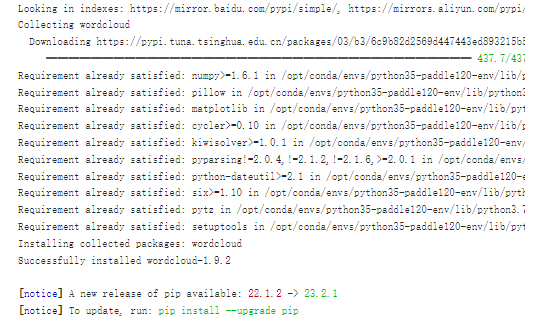
import json
import pandas as pd
import numpy as np
import matplotlib.pyplot as plt
from matplotlib.font_manager import FontProperties
from matplotlib import cm
import seaborn as sns
import jieba
import collections
import wordcloud
with open('work/review.json', 'r', encoding='UTF-8') as file:
item_list = json.loads(file.read().replace("}][{","},{"))
review_df = pd.DataFrame(item_list,columns=['author','pub_time','rating','title','content'])
print(review_df)
# # 删除缺失数值
review_df.dropna(inplace=True)
# 将缺失的评论情况设置为"放弃"
review_df.loc[review_df['rating']=='','rating'] = '放弃'
# # 将字符串格式的时间转换为datatime类型
review_df['pub_time'] = pd.to_datetime(review_df['pub_time'])
print(review_df)

#按照评分进行聚合
grouped=review_df['author'].groupby(review_df['rating'])
grouped_count = grouped.count()
print(grouped_count)
plt.figure(figsize=(10,5))
plt.bar(range(len(grouped_count.index)), grouped_count.values,color=['b','r','g','y','c','m',])
plt.xticks(range(len(grouped_count.index)),grouped_count.index,fontsize=15)
plt.yticks(fontsize=15)
plt.savefig('/home/aistudio/work/05.jpg')
plt.show()
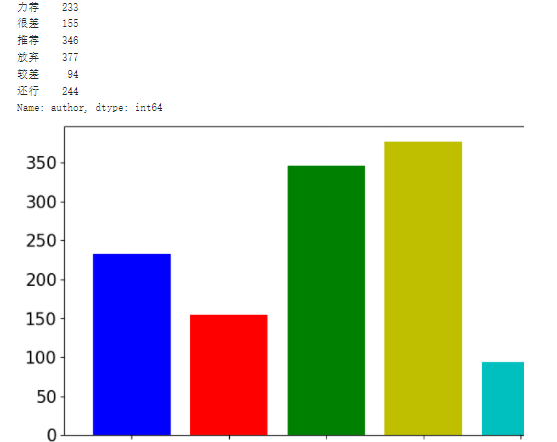
# 分析评论日期
import re
from matplotlib import dates
#显示matplotlib生成的图形
%matplotlib inline
#添加一个索引“pub_date”存储评论日期2020年2月到3月期间
review_df['pub_date'] = review_df['pub_time'].dt.date
review_df = review_df[pd.to_datetime(review_df['pub_date']).dt.year==2020]
review_df = review_df[pd.to_datetime(review_df['pub_date']).dt.month>1]
review_df = review_df[pd.to_datetime(review_df['pub_date']).dt.month<4]
# 根据评论日期进行聚合
review_date_df = review_df['author'].groupby(review_df['pub_date'])
review_date_df = review_date_df.count()
# print(review_date_df.index)
# print(review_date_df.values)
#创建一个画布指定宽、高
plt.figure(figsize=(20,10))
#设置显示中文
plt.rcParams['font.sans-serif'] = ['FZSongYi-Z13S'] # 指定默认字体
#绘制折线图
plt.plot(review_date_df.index.to_numpy(), review_date_df.values, marker='o')
#配置横坐标
plt.gca().xaxis.set_major_formatter(dates.DateFormatter("%m-%d"))
#这里是调节坐标的倾斜度rotation是度数以及设置刻度字体大小
plt.xticks(review_date_df.index.to_numpy(),rotation=45,fontsize=15)
plt.yticks(fontsize=15)
#配置坐标标题
plt.xlabel("发布日期",fontsize=15)
plt.ylabel("评论数量",fontsize=15)
#网格化
plt.grid()
#保存图形
plt.savefig('/home/aistudio/work/01.jpg')
#显示图形
plt.show()
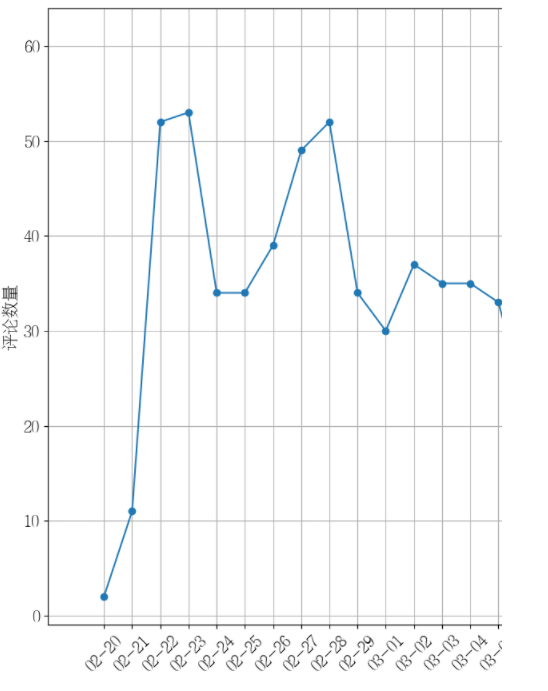
2.1数据分析之评论时间分布图
import datetime
# 指定多个时间区间
time_range = [0, 2, 4, 6, 8, 10, 12, 14, 16, 18, 20, 22, 24]
# 提取评论的小时信息
review_df['pub_hour'] = review_df['pub_time'].dt.hour
# 根据时间区间进行分组并统计数量
review_hour_range_df = review_df.groupby(pd.cut(review_df['pub_hour'], time_range)).size()
# 创建一个画布指定宽、高
plt.figure(figsize=(10, 5))
# 绘制柱状图
plt.bar(range(len(review_hour_range_df)), review_hour_range_df.values)
# 配置横坐标刻度
plt.xticks(range(len(review_hour_range_df)), review_hour_range_df.index, fontsize=12, rotation=45)
# 配置坐标标题和刻度
plt.xlabel("评论时间区间", fontsize=15)
plt.ylabel("评论数量", fontsize=15)
plt.yticks(fontsize=12)
# 网格化
# plt.grid()
# 保存图形
plt.savefig('work/03.jpg')
# 显示图形
plt.show()
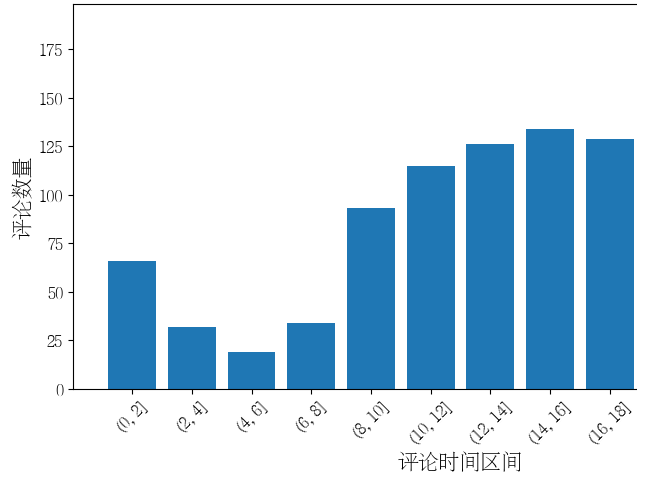
2.2角色评分
# # 电视剧人物的评分
# # 力荐+5推荐+4还行3较差2很差1
# roles = {'房似锦':0,'徐文昌':0,'张乘乘':0,'王子健':0,'楼山关':0,'朱闪闪':0,
# '谢亭丰':0,'鱼化龙':0,'宫蓓蓓':0,'阚文涛':0}
# 定义角色评分字典
roles = {'房似锦': 3, '徐文昌': 0, '张乘乘': 2, '王子健': 4, '楼山关': 1, '朱闪闪': 3,
'谢亭丰': 0, '鱼化龙': 2, '宫蓓蓓': 0, '阚文涛': 1}
# 遍历每条评论
for index, row in review_df.iterrows():
rating = int(row['rating']) if row['rating'].isdigit() else 0 # 将评分转换为整型非数字的评分设为0
content = row['content']
# 统计每个角色在评论中出现的次数
for role in roles.keys():
count = content.count(role)
roles[role] += count * rating
# 打印角色评分结果
for role, score in roles.items():
print(f"{role}的评分{score}")
# 绘制角色评分柱状图
plt.figure(figsize=(10, 5))
plt.bar(roles.keys(), roles.values())
plt.xlabel("角色")
plt.ylabel("评分")
plt.xticks(rotation=45)
plt.savefig('work/04.jpg')
plt.show()
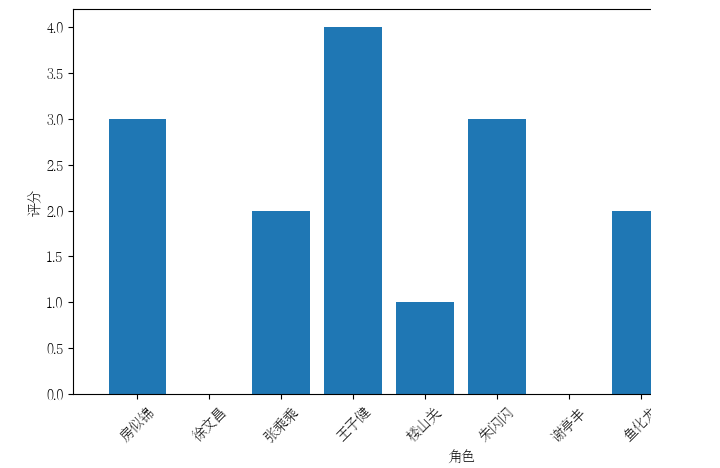
| 阿里云国内75折 回扣 微信号:monov8 |
| 阿里云国际,腾讯云国际,低至75折。AWS 93折 免费开户实名账号 代冲值 优惠多多 微信号:monov8 飞机:@monov6 |

